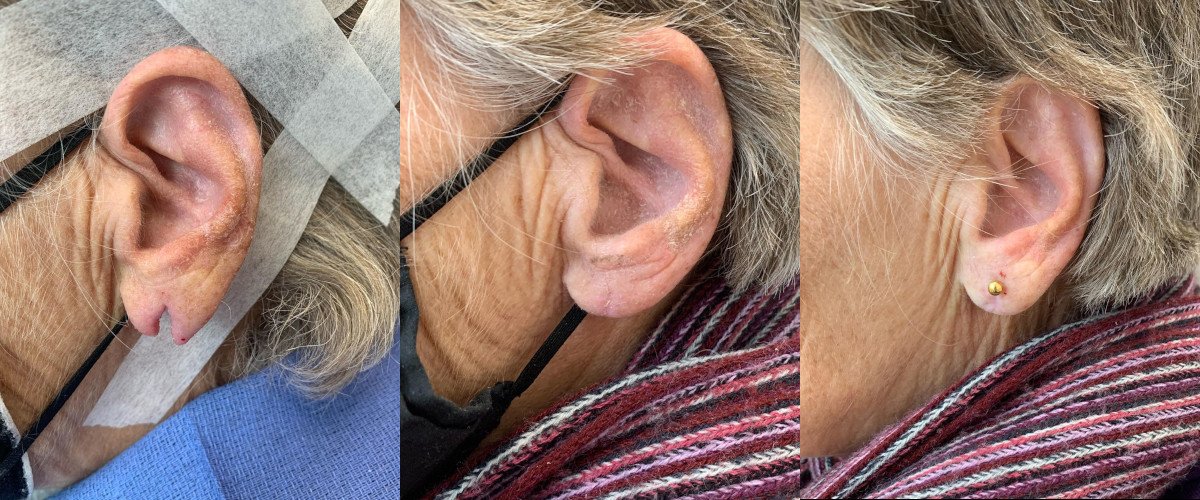Wear your favorite earrings again with an ear lobe repair
Client example of Earlobe Repair
Just to start out with a little visual - this was a photo of a little old lady who has loved long earrings her whole life. She's had a history of a split ear lobe and the other side was actually already repaired by another plastic surgeon out of state. But she came to me and I repair it for her - here she is about six weeks later. The repair looks pretty good.
She told me she was going to get her ears pierced after the procedure and she was on a lot of blood thinners, so I wasn't comfortable with her going to a mall piercing shop so I implored her to actually come back to my office in six weeks and I pierced them for her. I didn't want her to have a bad experience, a bruise, or a hematoma from a non-medical professional so that’s why I did it for her.
It just made her smile so that was very fulfilling.
What is an Earlobe Repair?
When it comes to ear lobe repairs, it's a really common problem. This is a very soft area. We don't have a lot of supportive tissue, unlike cartilage piercings. The lobe is much softer.
There's gravity pulling the ear down so, with heavy earrings, it eventually the whole moves its way down and splits.
And I wanna clarify, I'm sure there are women and men out there with almost torn earlobes with an elongated holes, but it's not quite there yet. They are often worried that they can't wear any earrings.
I can repair the elongated hole too. So it does not have to be split for you to see the plastic surgeon for a fix.
One of the most important things is to get the bottom border of that earlobe right. You don't want poor-quality work which you’ll see a notching, like a little bit of a “W” shape at the end of the earlobe. The most critical stitch that you could do is that really bottom one, getting that edge right is the key to this procedure.
How Is Earlobe Repair Procedure Performed?
Ear lobe repair is an office-based procedure. We numb the area, clean the skin very carefully, and I remove the area that's been healed.
We take a little edge of the tissue off, and then we have the healthy wound edge together and we put it back together.
What Is The Downtime And Recovery After Earlobe Surgery?
I normally tell patients that I leave permanent sutures in there that are removed in one week's time, so the patient's back in one week for suture removal, and usually, that's the only appointment that is sufficient or a small procedure like this.
I advise patients if they want to get the ears re-pierced to wait at least six weeks after the procedure to do so.
Gauged Earring Repairs Vs. Earlobe Repair
Now gauged ear repairs, we see this much more common among our younger patients who do ear gauging - also known as tissue expansion.
It's a little bit different when it comes to earlobe repair. It's also a bit more expensive to repair and reconstruct that since this is not about simply cutting the edge out.
In a gauged ear we actually have more skin and more tissue than required. Skin is viscoelastic and when it has certain stressors that is stretching it - whether it's artificially by gauge, it could be due to pulling, it could be due to weight gain - our skin has a property that it can respond to that stress and make more of itself. So gauged ear lobes are truly expanded skin so the anatomy is completely different from a torn ear lobe
There's a lot of skin accession excision that's being done for gauged ears. Excess skin is removed and we do the reconstruction as best as possible to try to get it so it has a nice curvature of a natural earlobe.
That can be done in the office or it can be done in a brief trip to the operating room. Either way, both are appropriate, but it's a bit more expensive to repair compared to a torn earlobe.
Elongated earlobes and ear lobe repair
If we have a long earlobe, again, there's too much excess skin so we would need to do some tailoring to shorten it. We absolutely can do that.
This is very similar to a labiaplasty procedure, where you don’t want to cut the bottom of the ear lobe and then sew it up. If you do, there’s going to be a scar along the bottom of the ear.
The way I would approach it is if we had too much skin and excess ear, I would cut a wedge out, almost like if we purposely tore the bottom of the ear lobe, remove the extra skin, and then close it again. That would both remove excess and lift the whole ear lobe as well with minimal scarring.
Conclusion
If you are interested in getting an ear lobe repair in Columbus Ohio, call our office or fill out the contact form to get an appointment with Dr. Okada. We’ll get you in the schedule and you can ask any questions during your consultation at our office in Dublin.

